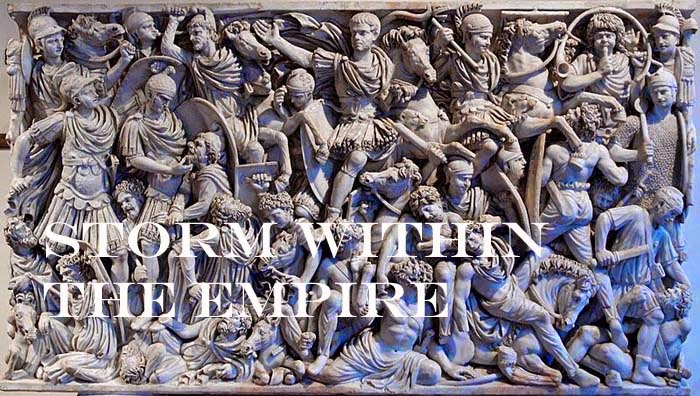The Ostrogothic army are an unusual combination of
knight class cavalry and skirmishers. The cavalry pose a definite threat to
Roman infantry and if supported by skirmishers they can quickly roll up a Roman
battle line. While Roman cavalry can counter the threat of the cavalry, they
are not of sufficient number to sustain a long engagement against them.
Home terrain for both armies is arable; BUA (hamlet)
is compulsory with two difficult hills and a wood are the selected options.
Game 1
Rome is defending and form their infantry line near
the base of a difficult hill, while the cavalry have taken a position on the
open flank. The Ostrogoth has evenly distributed their skirmishers on each
flank and all their cavalry have formed in the centre.
As a result of poor communication (low pip scores) the
Ostrogothic advance did not move as quickly as planned. Rome took advantage of
the delay to secure the hill. Once secured, the Roman infantry line advanced
forward. In the meantime, the Ostrogothic skirmishers on the right occupied the
Roman cavalry long enough for one of their noble cavalry to catch them in the
flank.
In two successive bounds, two equites were destroyed
leaving a sole Illyriani stunned. In an attempt to retrieve the situation, the
Roman commander moved his infantry line forward supported by the clibanarii.
The Illyriani retreated away from the immediate threat
leaving the Roman left entirely exposed while on the right, the auxilia were
holding their own against the Ostrogothic skirmishers. Emboldened by the
success on the right, the Ostrogothic chieftain led his nobles against the
Roman line eliminating half the legion and a unit of auxilia. With a third of
his army destroyed, Rome called for a general retreat. Score 0 – 4 for the Ostrogoth.
Game 2
Rome defending this time, the Ostrogoth selected a
position denying Rome the use of any terrain. It was a questionable choice as
the noble cavalry could only find sufficient ground to deploy on the extreme
right flank leaving the skirmishers to hold the hamlet and hills.
Rome set a quick pace leaving the Ostrogothic
chieftain no choice but to set priority on holding the high ground and hamlet.
The moment came when the Ostrogoth could deploy his
noble cavalry, but this was only half of their total number.
Rome easily countered the Ostrogothic threat and was
making headway against the skirmishers positioned on the hill and centre.
The effort proved decisive as Rome destroyed half of the
Ostrogothic skirmishers and scattered the rest. The loss of one noble cavalry
convinced the Ostrogothic chieftain tomorrow is another day. Score 1 – 4 for the LIR.
Game 3
For the final battle, the terrain was ideal for both
sides. The Ostrogothic army formed their nobles in the centre and skirmishers
taking positions on either flank. The Romans for their final battle mimicked the
Ostrogothic deployment which caused some consternation.
Unencumbered with armour, Ostrogothic skirmishers kept
pace with their cavalry while Rome marched steadfastly forward leaving a small
distance between battle lines.
The clash of arms echoed across the valley as the
battle lines quickly dissolved into smaller battles. The generals on both sides
were in the thick of the fight with both sides experiencing casualties (2 – 1)
but the Goths were gaining the upper hand.
The defenders in the small isolated battles quickly became
overwhelmed and this earned Rome two more casualties, but the Goths held their
own scoring an equal number bringing the battle to a close. Score 3 – 4 for the Ostrogoth.
II/67b Greuthingi 200 – 493 AD Terrain Type: Littoral if Herul, Arable if not,
Aggression 3
1 x general (3Kn), 5 x nobles (3Kn), 6 x archers (Ps).














No comments:
Post a Comment